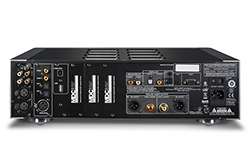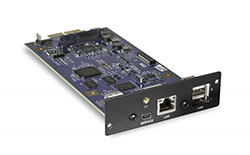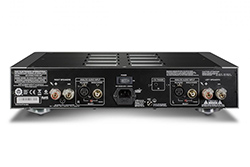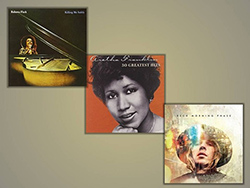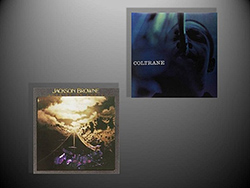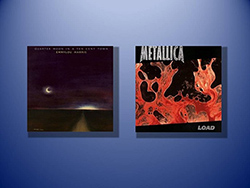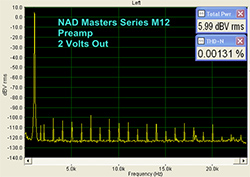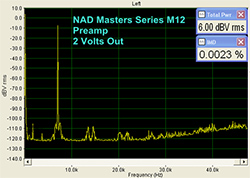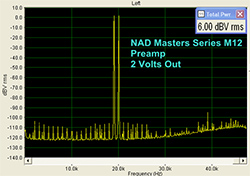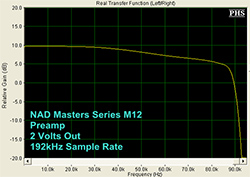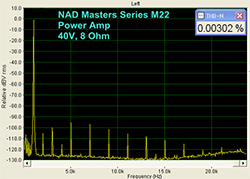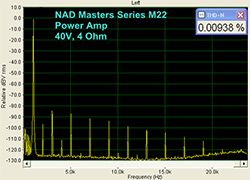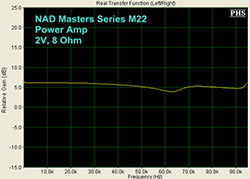NAD Masters Series M12 Preamplifier and M22 Stereo Power Amplifier Review Highlights
NAD calls their best electronics the “Masters Series”. The preamp and amp under review here are in this class of components. The M12 preamp is a digital preamp and DAC. It is a very unique design that up samples all signals to a high bit rate and then the signal is never converted back to analog in a traditional sense.
The M22 stereo power amplifier is no less innovative. It features a hybrid digital/analog design based on the latest nCore® circuitry from Hypex. This little amplifier puts out an incredible amount of power with extremely low distortion.
These products produced a liquid, emotive performance with a balanced tonal palette. I believe NAD rightfully deserves to be considered a major contender in the high end arena due in large part to the wonderful performance of the M12 and the M22.
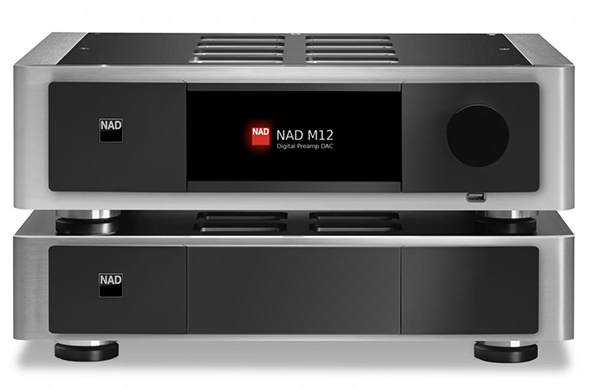
NAD Masters Series M12 Preamplifier and M22 Stereo Power Amplifier Highlights Summary
- All-digital architecture
- Flexible, future-proof modular design
- Stylish looks
- Smooth, liquid sound
- Ultra low distortion
- Extremely powerful amplifier with plenty of headroom
Introduction to the NAD Masters Series M12 Preamplifier and M22 Stereo Power Amplifier Review
NAD burst onto the scene in the late ‘70’s and early ‘80’s when they became something of a household name via a series of very affordable integrated amps, the most popular of which was the 3020. NAD sold a huge number of these amps and cemented their reputation as a high-performance, high-value brand. So I will forgive you if you still think of them as a mid-fi company. But it is high time to change all that and the M12 and M22 are in my mind nothing more than the most current harbingers of this new message.
NAD MASTERS SERIES M12 PREAMP AND M22 STEREO POWER AMPLIFIER REVIEW SPECIFICATIONS
NAD M12 Digital Preamplifier – DAC
- Design: Digital Stereo Preamplifier with DAC
- Inputs: XLR – AES/EBU, 2~Coax Digital, 2~Optical, 1~Asynchonous USB (Type B), 2~USB (Type A), 1 Unbalanced RCA, 1 Phono and 1 Balanced Analog
- Outputs: 1 Pair Unbalanced RCA, 1 Pair Balanced and 1 Pair Unbalanced Subwoofer
- THD: <0.005% (20Hz – 20kHz, 2V out)
- MFR: 20Hz – 20kHz ± 0.5dB
- Analog Input Impedance: 56 kOhms
- MC Input Impedance: 30 Ohms to 1 kOhm (Adjustable)
- Dimensions: 5.25″ H x 17.1″ W x 15.1″ D
- Weight: 17.9 Pounds
- Available Colors: Silver and Black
- MSRP: $3,499 USD
- Options: DD BluOS Module $449 and DD HDM-1 $299
NAD M22 Stereo Power Amplifier
- Design: Hybrid Digital Stereo Power Amplifier
- Power Output: 250 WPC (8 Ohms and 4 Ohms)
- THD: <0.005% (20Hz – 20kHz)
- Frequency Response: 3Hz – 100kHz -2.5dB
- Inputs: 1 Pair Balanced XLR, 1 Pair Unbalanced RCA, 12V Trigger
- Outputs: 1 Pair Binding Posts
- Input Impedance: Balanced – 200 kOhms; Single-Ended – 17 kOhms
- Damping Factor: >800 at 50Hz and 1kHz (8 Ohm Load)
- Dimensions: 4.1″ H x 17.1″ W x 14.9″ D
- Weight: 19.6 Pounds
- MSRP: $2,999 USD
- NAD
- SECRETS Tags: NAD, NAD Masters Series, M12 Preamplifier, M22 Stereo, Power Amplifiers
I have had the pleasure to audition many of NAD’s cutting-edge products in recent years. In each and every instance, I became increasingly impressed how NAD’s products could go toe-to-toe with many of the industry’s most storied and popular high-end brands. Suffice it to say that I see NAD as the “real deal”.
Exhibits A and B in support of my case are the Masters Series M12 and M22 amp/preamp combo. These are ultra modern products that are predicated on the most up to date circuitry out there. They are also NAD products which means that they take their own path to achieve great sound in a beautiful and efficient package. The preamp is a modular design that can serve as your system’s nerve center for . . . well, for “ever” really, add that the amplifier can realistically drive any speaker in the world and you will be on your way to one amazing set up
Design and Setup of the NAD Masters Series M12 Preamplifier and M22 Stereo Power Amplifier
The NAD M12 preamp is most accurately characterized as one of many products in a burgeoning category of “DAC/Preamps”. I say this because it does all its hard work in the digital domain. This includes volume control, subwoofer crossover, tone controls, etc. Digital sources remain in the digital domain while analog sources get converted to digital for manipulation. The signal never really gets converted back to analog, but instead is fed to a Class A buffer as a Pulse-Width-Modulation (PWM) signal on its journey to your power amplification component(s).
For this reason, NAD calls the M12 a “Digital Audio Hub”. In many ways, this concept appears to be the future of high end audio and not just from NAD but also from several other forward-thinking manufacturers out there.
In true NAD fashion, though, they take their own path . . . they march to the beat of a different drummer so to speak. Along these lines, the M12 operates with a native 35-bit word length. This isn’t a typo. The M12 doesn’t work at 16-, 24- or 32-bit; it really is “35 bits”. All sources are up-converted to 62-bit before the DSP functions are applied and then the signal is truncated back to 35-bit via a dithered process.
This is how the digital volume control can function without audible noise or any loss of musical detail that would be the result of truncating a 16- or 24-bit signal. It is a brilliant concept and is part of the reason NAD has enjoyed rave reviews of the products that are predicated on this concept not the least of which being John E. Johnson’s excellent review of the NAD M51 Direct Digital DAC that can be found here NAD M51 DAC Review. Please take a few minutes to read John’s explanation of the inner workings of the M51 and you will better understand how the M12 operates.
Another design and implementation concept that sets the M12 apart from its competition is what NAD refers to as their Modular Design Concept (MDC). The M12 unit has six bays available for upgrade and/or add-on modules. The stock unit comes with three modules pre-installed – the analog input card (3 inputs), a digital input card (optical, AES/EBU and S/PDIF over coax) and a USB input card (2 types) for full 24 bit, 192 kHz asynchronous inputs. (There is also a front-panel USB input.)
These installed modules can be upgraded via future releases of improved modules. But the NAD also has increased functionality available, particularly when compared to your more run of the mill competitors. This increase in functionality comes via a handful of optional MDC modules that are currently available or are in development.
One very interesting add-on module is an HDMI card which has 3 inputs and one output with video pass-through. This can be used for dedicated HDMI audio or for those who want to watch TV on their two-channel system. I did not evaluate an HDMI card in this review.
The other module that is currently available is a network audio module which is based on NAD’s BluOS system. I had one of these installed in my review unit. This card can be connected to your home network via Ethernet or WiFi and it also plays back aptX Bluetooth sources directly. This module is compatible with all the most popular online music streaming services as well.
I connected the BluOS module via WiFi then downloaded and installed the free NAD BluSound app to my HTC One phone. The system found all the music on my NAS server and I was able to play back even high resolution files wirelessly. I was really won over by this system which I will discuss in a little more detail later in the In Use section.
The backlit remote was fashionable and functional. I liked that its aluminum case had a comfortable trapezoidal cross section. The backlighting comes on when triggered by a motion sensor that sometimes was a bit reluctant to respond. All in all, though, the remote was compatible with the high level of performance available with this lovely NAD combo. (I found myself controlling the unit with my phone much of the time anyway.)
Two more quick notes about the M12 – it has internal bass management with dual (stereo or mono) unbalanced subwoofer outputs. It also contains IR repeaters and multiple 12V triggers. Thus it is compatible with advanced control systems.
Now let’s talk about the M22 stereo power amp. It has one very obvious peculiarity (to me, at least) – it is physically much smaller than the M12 preamp. I was going to be stacking these components in my rack and I debated for a few minutes if the amp should be on top or on bottom. I would up with the amp on bottom because it just felt right, you know?
NAD classifies the M22 power amp as a “Hybrid” design utilizing Nypex nCore circuit designs predicated on the UcD concept. According to a NAD white paper on the subject, “the UcD concept is a switching analogue amplifier with all parameters highly optimized to allow self-regulation.” The design ultimately allows 20 dB more feedback to be used which results in reduced distortion. NAD also claims UcD has “amazing characteristics of load invariance and high current capability.”
The M22 uses the latest generation of NAD’s PowerDrive technology which ensures up to 250 wpc of continuous power output with reserve capacity of up to 600W of dynamic power into a 2 ohm load. This PowerDrive circuitry is claimed to preserve the life in music while allowing the M22 to demonstrate wide compatibility with pretty much any speaker you may be using.
The M22 is DC Coupled throughout with no capacitors in the signal path. DC is rejected by way of localized negative feedback.
The power supply is an advanced regulated switch mode power supply which promises low noise and an energy efficient design.
Finally, electronic protection circuits eliminate speaker relays.
The M22 has balanced and unbalanced inputs, a trigger switch and rugged five-way binding posts (one pair per channel).
These products are quite solidly built with a modern, industrial appeal. The M12 in particular is very nice looking with its clean lines and two-tone case. The front panel has a large volume knob but the front is mostly dominated by the good sized touch screen display. You can use this screen or the fully-functional remote to access and control the tight menu structure.
I placed the M22 amp on bottom, connected it to the M12 preamp via a pair of balanced interconnects. I connected the 12V trigger for automatic turn-on of the amplifier. I also connected a Bluetooth antenna and a WiFi dongle to the BluOS module. I connected my Blu-Ray player, turntable, laptop and surround processor’s main channel outs to the M12.
I used a pair of satellite speakers with a single subwoofer for most of my critical listening. So I connected the satellites to the amp via banana plugs while connecting the sub to the unbalanced output of the M12. I used the internal crossover and trim functions for bass management. Now I was ready to get started evaluating the system.
The NAD Masters Series M12 Preamplifier and M22 Stereo Power Amplifier In Use
The M12 is a surprisingly flexible component. The user has a wide range of control functionality within the intuitive menu system. You can select inputs, rename inputs, make inputs active or inactive, set up and control the subwoofer(s) including trim functions and high and low pass filters. The unit has bass and treble controls, a balance control (nice) and fixed gain settings for use as a home theater pass-through. I could go on, but suffice it to say that NAD has packed this preamp with all the control functionality I could ever want.
So what kind of summary can I think of to describe the audible character of these components? Well I did a quick, informal word count on my listening notes and found a recurring theme in my listening impressions. The words that kept showing up were words like analog, liquid and emotive. Yep, the NAD products amazed me with an analog-like richness despite their digital architecture. This is not what I was expecting based on my past experience with Class D amplifiers. I was expecting an etched, forward, maybe even harsh sound. But that is not anything like what was heard.
Let’s start by discussing the sound of computer audio over the asynchronous USB interface. The albums I’ll write about immediately below were all 24/96 FLAC files that I downloaded from various internet sources. They were played over a Dell laptop on JRiver Media Center 20.
Leading off with Roberta Flack “Killing Me Softly”, I heard what was described as an eerie analog-like quality. I went on to say that the effect was actually jarring in its preeminence within the performance envelope.
This analog quality was further reinforced with Aretha Franklin’s “30 Greatest Hits” album. In this case, I pegged the sound as analog but I also went on to note the liquidity of the music. This was especially prominent on “Freedom” where Aretha’s voice was crystal clear and lifelike. Other songs on this album did not fare as well because the NAD combo was capable of revealing flaws in many of the older recordings I auditioned.
So I decided to try something on the modern end of the spectrum and cued up Beck’s award-winning “Morning Phase”. This Beck album proved to be a great test of the NAD’s excellent bass response. This album can tend toward being too warm, but over the NAD, the bass was a spectacular accompaniment to the music. It was full and deep to be sure but it was also very much in rhythm and in tune. I was very impressed by what I heard in the bass on this record.
My main impression of “Morning Phase” was of a smooth and low distortion sound that was free of any nasty artifacts that were endemic of the older recordings I had started off auditioning. This meant that the NAD gear was able to step aside and allow the music to shine in a way that held me spellbound throughout the entire album. This was indeed a high-end performance that I would challenge any other amplification product to try and match.
I did listen to more than a few LP’s over the NAD’s phono input. Yes, the stock M12 comes with a phono input that is fully adjustable for load and gain via the on-screen menus. My cartridge is a Sumiko Blackbird which is a high-output MC design that is designed to drive a typical MM load/gain setting.
I started with an original pressing of “Coltrane” on the Impulse! Label in Stereo. This particular album, produced by Bob Thiele and engineered by Rudy Van Gelder, has been pristinely preserved. This was the debut of the classic “Trane Quartet” and it signified his return to a more melodic style. I personally feel that Coltrane was THE jazz virtuoso on sax
The NAD brought out the emotion like never before. It was amazing!!! This too was not expected from a digital component. As I mentioned earlier, most of the Class D amplifiers I have heard have at least some amount of a “zzzzzt” sound that can be very annoying. Class D amps have also sounded rather grainy to me in the past. Well, I heard none of that kind of mess from the NAD M22. The performance was simply pure, clean and balanced.
The frequency balance was spot on as in “The Inch Worm” which had deep bass, sparkly cymbals and a clear midrange. This top to bottom balance was in many ways the NAD’s calling card and it meant that you would hear every note with the correct inflection and nuance. This is a big part of what the Coltrane sound was all about
The pace on “Miles’ Mode” was as blistering as I have ever heard. The NAD left nothing on the table with this song. This was as pure sounding as I’ve heard this album; dark backgrounds, with brilliantly clean leading edges and absolutely no overhang.
Later I gave a listen to Jackson Browne “Running on Empty”. Like “Coltrane” above, this was also an original pressing. Songs on this album were cobbled together and recorded in various live venues, hotel rooms and even one on the band’s bus. This was a band on tour for sure. This was one of my favorite albums in high school so that means it will be a lifelong favorite 🙂
Even I was taken by surprise when it came to the low levels of background noise on this record. It still sounded so true to the music that I fell in love with all those years ago. The variety of the musical styles, the instrumentation and venues were apparent on each individual song. Over the NAD duo it became something of a “Master Class” on how to reproduce music in the home.
Whenever I review real high end equipment, there are always times where I just let the music and the performances speak for themselves. This was one such instance and the NAD boxes spoke with an authoritative voice that had me riveted.
The M12 review unit that I had included the NAD BluOS module that allows one to play music over their home network (or directly over Bluetooth). It took me a few tries to get it to work because the original firmware had issues. Once I updated the firmware, then the Bluesound system connected quickly and worked quite well.
I have hundreds of albums on a NAS server. These files range from MP3, to FLAC, to WAV, to AIF, to ALAC, to DSD. The BluOS module could play them all. And it did it wirelessly. What I did was download and install the free app onto my HTC One phone. This app found all the music on the NAS and indexed it to a reasonable degree. If I owned the BluOS, then I would need to spend some time reacquainting many files with their cover art, for example. But for the purposes of this review, the system worked great just the way it started up.
The module and app conspire to replace iTunes or JRiver or whatever media player you are using. I found that the Bluesound app worked best in a playlist mode. So even short listening sessions started with me creating a playlist on the fly. I was constantly searching for the next track to add and once the queue was more than about 5 songs or so then I would marvel at the eclectic choices I had made! Hey, it was serious fun! But it wasn’t just easy and fun – the system could stream high resolution seamlessly which meant I got some incredible audio performance from this system.
But even material sourced from Redbook CD’s were a joy – take Emmylou Harris’ “Quarter Moon in a Ten Cent Town” which I ripped as a FLAC file from the CD by Rhino. On “To Daddy” (written by Dolly Parton), Emmylou’s plaintive voice floated between the speakers and really communicated the song’s bittersweet message while more upbeat songs like “Leaving Louisiana in the Broad Daylight” benefitted from the strong bass and broadly fleshed out analytical accuracy of the sound. Despite an analytical edge, the emotion in the music remained intact not having been squelched by the NAD’s modern design architecture.
Despite that it wasn’t one of Harris’ big hits; my personal favorite track on this album is “One Paper Kid”, a duet with Willie Nelson. Over the NAD combo, there was excellent separation of voices while the strings amazed me with their brilliant presence in the room. Paradoxically for an acoustic track, this song highlighted the dynamic capabilities of the NAD system which were beyond reproach.
I closed out my serious evaluation with Metallica “Load”. Why, you may ask? I say “why not”?!!!! The NAD combo would be a great choice for anybody who enjoys rock music – they have wide dynamic range (macro) and with “sleeper” microdynamics. (They aren’t in your face but over extended listening you find that the NAD setup has a great deal of headroom). Plus once in a while you just have to crank it.
This whole album is a lot like the fat lady singing. I am totally sold on this set up now and a big part of that is “Bleeding Me”. This song tests every aspect of the system. The NAD stared down Satan and did not flinch! Bass, treble, mids, oh my! Dynamics? Check. Are you not entertained? I am!
The NAD Masters Series M12 Preamplifier and M22 Stereo Power Amplifier On the Bench
All below tests were run with one channel driven. On the M12 preamp, the signal was fed through the left channel balanced input to the balanced pre amp output. On the M22, I used the left balanced input through to the left speaker output.
The first test I ran on the M12 was a 1 kHz sine wave at 2V RMS. THD+N measured just 0.00131%. Check out the very different and orderly harmonics. This harmonic structure is indicative of a unique design.
This is the Intermodulation Distortion Test with signals at 60 Hz and 7 kHz. The M12’s measured IMD at 6 dBV (2 Volts) came to just 0.0023%.
This is the other IMD Test we run with signals at 19 kHz and 20 kHz. The B-A peak is the difference between the test signal and the level of the 1 kHz tone generated in sympathy to the two test tones. I measured this on-screen and got a B-A peak response of -123.5 dB at 2 Volts output!
This plot shows the frequency response of the NAD M12 at 2 Volts output. I had the M12’s ADC set to 192 kHz for this test. The plot is nearly flat to 20 kHz where it begins a slow drop to – 5dB at around 85 kHz at which point the amp’s filters kick in.
I wanted to show how the filters worked when the M12’s ADC was set to 48 kHz. Notice the sudden roll off starting at 24 kHz just as one would expect.
The M22 tested at 10V and 8 ohms (12.5 watts) presents a very clean distortion profile. The calculated THD+N is just 0.00113%.
Increasing the output to 40V into 8 ohms (200 watts), the THD+N remained well below the threshold of audibility at just 0.00302%.
Check out the response at 40V into 4 ohms (400 watts). The distortion + noise was still under 0.01%! The resistors were dissipating a lot of heat during this test.
The M22 IMD test at 19/20 kHz and 2V shows a B-A peak of around -90dB.
Here is the M22’s frequency response into 8 ohm at 2V. It was essentially flat from 2 Hz to 20 kHz.
Conclusions about the NAD Masters Series M12 Preamplifier and M22 Stereo Power Amplifier
The NAD M12 and M22 amps impressed me more than any amplification component I have reviewed in the last several years. Due to the products’ digital DNA, I was prepared to hear a bright, grainy or thin sound. What I heard was in reality the very exact opposite of this.
The M12/M22 products offered a sound that was always liquid and emotive. The sound was reminiscent of good old Class A amplification in this regard. They thankfully differed from Class A in being able to deliver huge gobs of power with a lifelike microdynamic structure which impressed me more and more each time I listened to the amps. And the frequency balanced held up even when I pushed the amps.
The units also shone on the test bench with high power output, low distortion and a distortion profile that was unique among amplifiers I have tested. I believe this balanced harmonic structure had much to do with the smooth and non-fatiguing sound.
NAD has brought to market a pair of spectacular products with these amplification components. People take notice – NAD deserves full consideration as a contender in the high end. Please do yourself a favor and be sure you fully audition these fine products before you make a final purchase decision.





